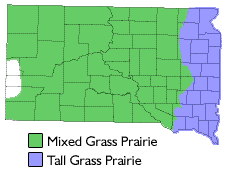Plants
Trees
As early settlers ventured west into South Dakota, they encountered a landscape sparsely adorned with trees. However, these pioneering individuals quickly recognized the profound value of trees in our prairie terrain. Today, trees stand as a vital and renewable resource in our state, playing a multifaceted role in our ecosystem.
South Dakota boasts a diverse array of forests. The Black Hills National Forest, protected since 1987, spans over 110 miles in length and 70 miles in width, serving as a sanctuary for more than 200 wildlife species.
In the southeastern part of the state, you'll find the native upland forest at Newton Hills State Park, sprawling across 188,000 acres, predominantly home to oak and black walnut trees and providing refuge to white-tailed deer, wild turkey, and various bird and fur-bearing animal species.
Further, the remnant floodplain forest nestled at Running Water, South Dakota, is composed of eastern cottonwood, willow, green ash, and elm trees, flourishing within the floodplains and tributaries of the Missouri River.
However, our most extensive forests are the urban forests, thriving within our communities, cities, and towns. These urban trees offer vital benefits, including energy conservation through shade, wind reduction, increased property values, and reduced noise in neighborhoods. We encourage homeowners to contribute to their communities by planting trees, particularly in April when we celebrate Arbor Day on the last Friday of the month.
Why are trees so essential? Through the use of windbreaks, they reduce soil and water erosion, provide shelter to livestock during the harsh Midwest weather, and enhance winter driving conditions with snowfence windbreaks. These windbreaks are carefully planted and managed to protect homes, farms, ranches, and, most importantly, to conserve our invaluable natural resources.
Cropland
In South Dakota, our lives are intricately tied to the land. With agriculture at the forefront, it's more than just an industry; it's a way of life, contributing a staggering $17 billion to our economy. Approximately 37% of our land resources are dedicated to cropland, making it an integral part of our identity.
Corn
In a typical year, South Dakota dedicates over 2.5 million acres to corn cultivation, yielding a harvest of more than 200 million bushels. Corn is more than just a staple; it's a dietary cornerstone, present in nearly 4,000 food products. Corn syrups sweeten countless food items, and its industrial applications range from plastics to motor fuel additives. Predominantly grown east of the Missouri River, southeast South Dakota is home to the largest corn production, often requiring irrigation.
Soybeans
South Dakota-grown soybeans serve a diverse array of purposes, providing protein meal and oil. A single 60-pound bushel yields 48 pounds of meal and 11 pounds of oil, benefiting animal feed, bakery products, shortening, and even printing ink. Typically planted in rotation with corn, soybeans thrive in eastern and southeastern South Dakota.
Wheat
South Dakota boasts three wheat varieties: hard red winter, hard red spring, and durum. Hard red winter wheat, planted in fall and harvested in mid-summer, produces some of the world's finest bread-baking flour due to its high protein content. The state is one of six to cultivate durum wheat, crucial for pasta production. In an average year, over 3.5 million acres in South Dakota are dedicated to various types of wheat.
Sunflowers
South Dakota, alongside North Dakota and Minnesota, leads in sunflower production, contributing 95% of the nation's output. We cultivate two types: oilseed varieties for oil and meal, and confectionery varieties for human consumption and birdseed.
Other Crops
South Dakota is a top-ten producer in various small grains. With over 50 million bushels of oats annually, primarily for livestock feed, oats have also enjoyed renewed popularity in health-conscious diets. Barley is another prominent small grain, and our rye production ranks us as the nation's leading producer. Flaxseed production has surged over the past decade, often exceeding one million bushels.
Additionally, South Dakota yields up to 15 million bushels of grain sorghum and 6 million tons of sorghum for silage annually, a vital resource for livestock. Our state also produces significant amounts of hay, with alfalfa leading the way, providing over 75 million tons annually through multiple cuttings.
Grasslands
Grasslands stand as one of South Dakota's most vital natural assets, serving as the bedrock of an intricate food chain that sustains countless wildlife species and supports our livestock industry. These resilient grasses have the remarkable ability to generate their own sustenance, rendering them a renewable resource under judicious management.
South Dakota predominantly comprises two types of grasslands: the Mixed Grass Prairie and the Tall Grass Prairie. The latter was shaped by deposits left by the glacier that carved the Missouri River, along with abundant annual rainfall.
Our state's grasslands are versatile, offering a multitude of benefits, from watershed management and recreational spaces to providing critical wildlife habitats and supporting hay production. However, the most widespread use is livestock grazing.
Remarkably, one-third of the nation's private land, spanning 642 million acres of grassland, is dedicated to sustaining livestock. The remainder falls under the stewardship of state and federal agencies, including national grasslands, parks, and wildlife refuges, collectively ensuring the preservation of these invaluable ecosystems.











Plant Activities

A coloring book and activity guide to teach the importance of trees, and the many jobs they perform in our environment.
More Plant Materials & Activities
A large list of hands-on activities to use with kindergarten aged children to explore plants.
Through the Arbor Day Foundation, Nature Explore supports efforts to connect children with nature by offering a variety of resources. Family resources full of activities can be downloaded for free or ordered online for $25.
Smokey Bear Kids has lots of interactive activities for kids to explore wildfire prevention.
Firewise Teaching Tools is full of information to teach wildfire safety.


